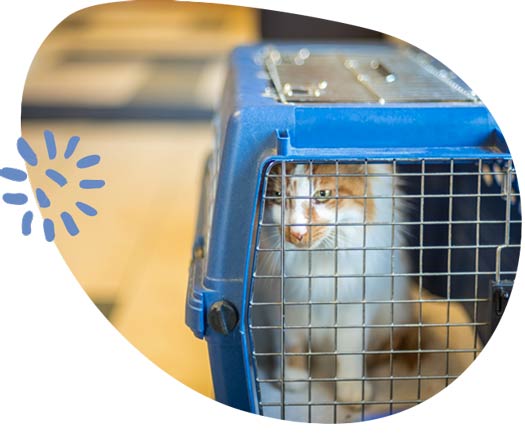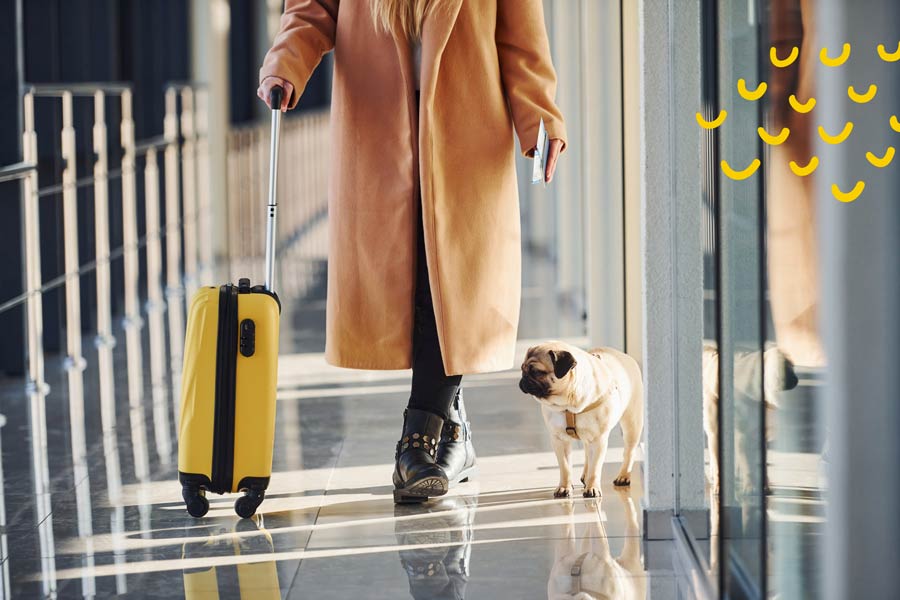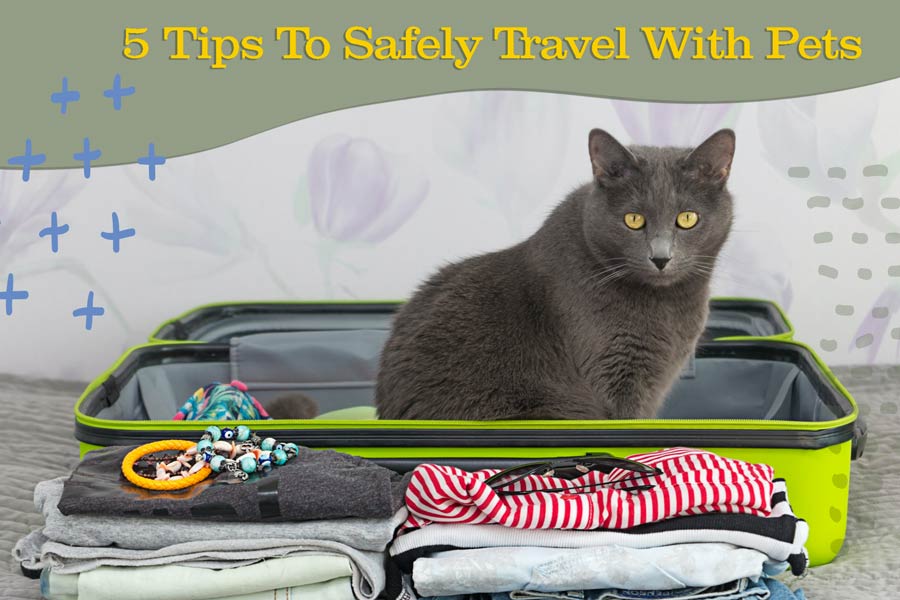What’s better than a travel adventure? A travel adventure with your pet, of course! Bringing your pet along on your dream destination (or even a weekend getaway) can spell twice the fun! But it can also spell twice the trouble without proper planning, and in this piece, you’ll learn everything you need to know to travel safely and happily with your pet!
1. Begin by Asking Yourself Three Questions
When making the decision to travel with your pet, you first need to answer three questions:
- Where am I going to go?
- How am I going to get there, and how long will it take?
- What am I going to do there?
These are important questions to answer because they often determine your mode of transport, the time it takes to reach your destination, whether your pet can have a good experience at your destination, what vaccinations you might need while crossing state lines or getting your pet through airport security, and so forth.
Traveling with your pet by plane, for example, is a whole different ball game than traveling with them by car. And there’s a big difference between traveling with your pet for short stretches on a bus, for example, vs. having them in either a car or plane for extended periods.
Not only this, but there’s also a big difference between keeping your pet in your hotel room while you’re, say, at the Magic Kingdom, and taking them hiking with you on a day-long nature adventure.
2. Select Your Tier of Pet Hospitality
Pet hospitality refers to how welcoming your lodging accommodations will be to your pet. If you’re visiting a family member or someone you know well, it’s generally easy to determine this. But it’s important to understand that all “pet-friendly” accommodations are not created equal and come into three different tiers that run from least friendly to most friendly:
Pets Accepted
This is generally shorthand for, “Pet’s will be tolerated, but we’d prefer they weren’t here, and you’ll need to abide by stringent guidelines.” (For instance, crating your pet when you’re not in the room.)
Pets Welcome
Pets are welcome, and accommodations will gladly be made for them. (Even so, it’s crucial to find out precisely what this means since practices and policies can differ between motels, hotels, and Airbnb hosts.)
Pet Focused
Or “Pet Optimized” — This top-tier offering is exactly what it sounds like. In Pet-Focused or Pet-Optimized accommodations, everything is designed with your pet in mind. It’s not just that your pet is welcome. It’s that your pet (and your needs as a pet-parent) are catered to to ensure you both have the best experience possible.
3. Prepare and Practice
Suppose your pet is new to traveling or isn’t yet well adjusted to traveling. In that case, it’s important to get them prepared for your actual adventure. Different modes of travel require your pet to be prepared for different things — and they need time beforehand to be exposed to them and have some practice with them.
 Car Travel
Car Travel
If you plan to travel with your pet in a car, the most essential thing to think about is their safety. Never allow your pet to ride on your lap or to ride with their head out the window. (You’d be surprised at the number of dogs that are injured or killed this way.)
When traveling by car with your pet, they need to be seatbelted into their harness or in a secured crate. Introduce your dog or cat to these travel options very gradually, taking things in steps. First, get your dog or cat used to the seatbelt harness or crate while the car is parked. (Rinse and repeat.) Then, get them used to being in the parked car buckled into the seat. (Rinse and repeat.) Next, take them on a very short drive in their seatbelt harness or crate to see how they do, working up to longer and longer rides. As always, reinforce with affection, praise, and healthy treats.
Air Travel
In principle, everything that applies to getting your dog or cat used to traveling in a car applies to a plane as well, with the only difference being your pet will have no choice about being in a crate. Obviously, you can’t practice getting your pet used to a crate that’s already inside a plane or acclimate them to the experience with short rides. You can, however, get them used to riding in their crate in the car, and this should serve to make the airborne crating experience more positive.
 Flying with your pet commercially — regardless of whether they’re small enough to travel in-cabin with you or large enough that they’ll have to ride in the cargo bay — comes with a host of strict regulations and conditions. These can be extensive, and you’ll need to do due diligence. If your pet can’t travel in the cabin with you, you’ll need to look into whether your pet will be transported in a temperature controlled environment, whether they’ll be checked on, and so forth.
Flying with your pet commercially — regardless of whether they’re small enough to travel in-cabin with you or large enough that they’ll have to ride in the cargo bay — comes with a host of strict regulations and conditions. These can be extensive, and you’ll need to do due diligence. If your pet can’t travel in the cabin with you, you’ll need to look into whether your pet will be transported in a temperature controlled environment, whether they’ll be checked on, and so forth.
If you want to get around restrictions and have maximum transparency into your pet’s care and travel conditions (and pay significantly extra for doing so), you can look into pet-optimized air-travel companies like PetJets.com or AirAnimal.com.
Bus or Train
If you’re traveling by bus or commuter train, the key to acclimating your pet is simply a matter of taking lots of practice runs for longer and longer periods. But because the conditions on a bus or train can be far more variable than those of a car or plane, you’ll need to ensure your dog is well-socialized and can feel at ease around other people and other animals.
4. Have an Arsenal of Stress Busters on Hand
For all the preparation and practice you give your pet, some may still feel anxious about travel. The first idea that will occur to many pet parents when traveling with an anxious pet is to sedate them. At Holistic Actions, we generally advise against this practice, though in some cases it may be necessary and you will need to use the HMDM (Holistic Medical Decision-Making) protocol to determine your exact course of action and after-care.
In many cases, anxious pets — provided they are well prepared for travel — can be significantly soothed with what we like to think of as natural “stress busters.” Though different pets respond differently to different stress busters, here are some of our favorites.
- Snuffle/Activity Mats
- Flower Essences
- CBD oil and other related products
- Melatonin
- Nobileton
- Reiki / T-Touch
- Anti-Anxiety Wraps
5. Gather the Essentials
You’re getting so close to your travel date, and it’s time to get everything together for your big adventure! Here are the most essential items to gather together!
- Food and water. For any trip more than several hours long, this should go without saying. If you’ll be with your pet on the road for long stretches, they’ll enjoy a healthy snack or two as much as you do.
- Health/Rabies certificates. Though it’s pretty rare when crossing state lines to be asked for a Rabies certificate, you’ll want to have this just in case. If your pet will be traveling by air, be sure to check exactly which vaccinations might be required to receive clearance.
- Parasite Control. Ensure your pet is free of parasites before travel. Not only are these parasites harmful to your pet, but you also don’t want ticks and fleas and other pests to end up in your car, in a plane, or anywhere else your pet may be.
- Comfort objects from home (favorite toys or blankets, pacifiers, etc.) Give your pet a piece of home to take with them on their travels. The familiar shapes, textures, and smells of their favorite things will help them feel more at home, wherever they are.
- Back-up collars, leashes, and tags. These things can too often be lost or misplaced or simply left behind on your travels. Having back-ups on hand means that if something goes missing, you can instantly solve the problem. You also minimize the time and risk of your pet not wearing identifying information or being off-leash in unsafe areas.
And there you have it! Everything you need for a safe, happy travel adventure with your furry friend! Good luck, godspeed, and happy “tails”!


